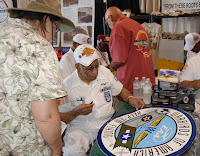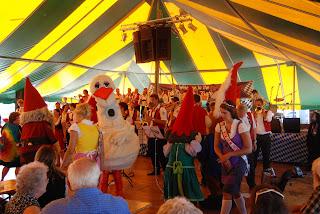
Sunday we moved up the coast of Lake Superior to a little town, Schroeder. Most
of the towns along Minnesota’s North
Coast were founded by Finn’s Norwegians, and people from that region in Europe.
They didn’t find the climate too intimidating, and the fishing was similar to
the ocean fishing they were used to. There are towns like Tofte, and Lutsen just to
the north. We went to a town called Two
Harbors, a Taconite shipping port to see a close up view of a Taconite dock,
and their world famous tourist spot, the
founding office for 3M!
 3M or Minnesota Mining and Manufacturing Co. as it was founded
was started by a group of men who believed that they had discovered a place
along the coast of the lake where there was carborundum, the 2nd hardest
mineral, and the abrasive in sandpaper.
They came to Two Harbors, found an attorney, set up the company, and
began selling stock. Unfortunately for them, the carborundum mine turned out to
be a different mineral, and therefore worthless. This left them with a task that
turned out to be providential. They had to think if a couple of new products.
One to be the abrasive for their sandpaper, and two for the mineral in their
mine. 3M as the company became known after many years has been inventing their way
to success ever since. I use them as examples in my new products class almost
every day I teach. The type of ingenuity they
use is evidenced in the development of one of their primary products,
adhesive tape. As I mentioned the company was
making sandpaper. The largest market for his was the automotive
business, particularly body shops. When making a call on one of his customers a
company salesperson saw the difficulty the painter had with the new two tone
paints that were popular. He went back
to his company, and they used some of the adhesive technology that made the
abrasive stick to the paper, to create masking tape. Our company sold to
several of 3M’s divisions. They have a
wide variety of creative programs designed to create new products, and extend a
line when they have found something unique. Look at the incredible number of “Post-it”
products that are on the market today. They are the result of the company’s
culture of taking an original creation of masking tape, in the early 1900’s and
combining it with the ingenuity of a 3M
employee who in the 1980’s had his notes falling out of his hymnal in choir
practice.
3M or Minnesota Mining and Manufacturing Co. as it was founded
was started by a group of men who believed that they had discovered a place
along the coast of the lake where there was carborundum, the 2nd hardest
mineral, and the abrasive in sandpaper.
They came to Two Harbors, found an attorney, set up the company, and
began selling stock. Unfortunately for them, the carborundum mine turned out to
be a different mineral, and therefore worthless. This left them with a task that
turned out to be providential. They had to think if a couple of new products.
One to be the abrasive for their sandpaper, and two for the mineral in their
mine. 3M as the company became known after many years has been inventing their way
to success ever since. I use them as examples in my new products class almost
every day I teach. The type of ingenuity they
use is evidenced in the development of one of their primary products,
adhesive tape. As I mentioned the company was
making sandpaper. The largest market for his was the automotive
business, particularly body shops. When making a call on one of his customers a
company salesperson saw the difficulty the painter had with the new two tone
paints that were popular. He went back
to his company, and they used some of the adhesive technology that made the
abrasive stick to the paper, to create masking tape. Our company sold to
several of 3M’s divisions. They have a
wide variety of creative programs designed to create new products, and extend a
line when they have found something unique. Look at the incredible number of “Post-it”
products that are on the market today. They are the result of the company’s
culture of taking an original creation of masking tape, in the early 1900’s and
combining it with the ingenuity of a 3M
employee who in the 1980’s had his notes falling out of his hymnal in choir
practice.
The Taconite loading facility in two harbors was very close
to shore, and we observed it on a couple of occasions. The process is expected,
with the short train cars being pushed out, then individually “drained” from
the bottom into the long chutes. These chutes go into the holds. The train
moves back and forth, and different cars are selected so that the boat is
loaded evenly. We heard that if you just start filling in one end the boat will
break in half.
The town restored the old steam tug that was used here prior
to the advent of bow thrusters/ The Edna G was an interesting tour. They also
had two restored locomotives, the largest, and latest from the WWII time frame.
If you think, like us, that it was strange that they could get a huge
locomotive built during the shortages of the war, you’ll begin to understand
how important the iron ore from this area was to our winning the war.
We made a few other side trips while staying in Schroeder,
to the Split Rock light house, a taconite processing facility, and many of the
falls coming off the mountain behind the lake on the way t o the big lake.
Split Rock was a light house requested by the ship owners after great November storm sunk many ore boats. The
Edmund Fitzgerald was only the latest on
long line of ships going down in a November Lake Superior storm. After
the construction of Hwy 61, our path up form Duluth, the light became a
favorite stop and the most photographed light in the US (at least according to
the locals.)The overall facility was large with 3 keepers houses, a few barns
etc. Seemed like overkill to me for a lighthouse operated from May-December.
Very nice restoration, and great staff.
The Taconite factory had a tour, but no pictures were
allowed, so this shot from up above will have to do. Their plant is about a
mile long and takes the raw ore from the mines 40 miles north in the small ore
cars we’ve seen. Then through a series of crushers, mixing into a slurry, and
magnetic separators they extract iron. They then form a pellet about ½ the size
of my little fingernail, including some other additives that make the steel
better quality. These are what is loaded into the “lakers” and “salties” 68,000
tons a batch for shipment down lake. The
tailings are then pumped, still in the slurry up to a spot on the way back to
the mine. There they have an environmentalist approved dam, and fill area, and
the liquid then is returned to the plant to begin the crushing process again. This
last step is extremely costly, (and since what they have is essentially our
trap rock) it appears to me they are ‘disposing of” tons of good road bed!!!
The falls are interspersed about every few miles up the
highway. The one pictured here is Gooseberry Falls, about medium in intensity,
and near the maximum in height. Because the water flow was relatively low,
there is a lot of play going on here. There are 4 levels and there are people
in the water in each of them. There is a state park at each falls, and most
have camping. The north shore is a place that prior reservations are necessary to get some of
the best spots…. But until we got here, we didn’t know what to reserve! We’ll
probably come back to this area.




















































